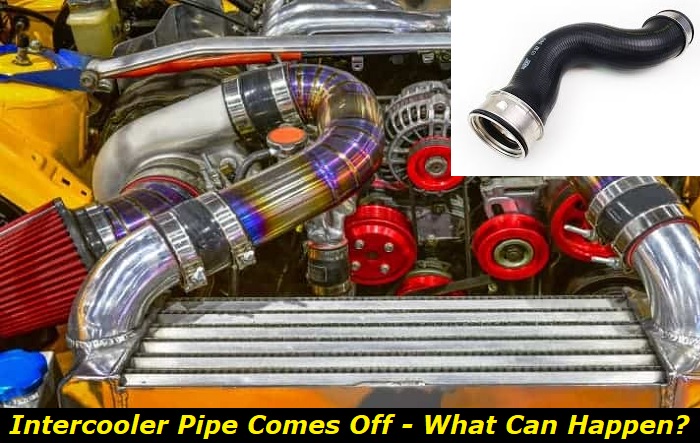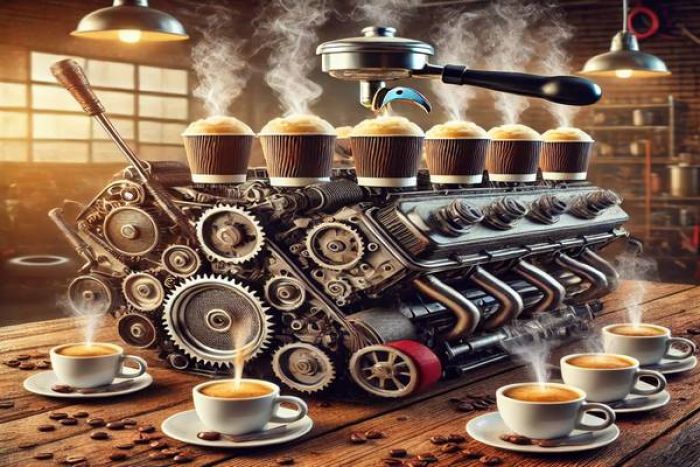If you drive a car with a turbocharger or supercharger installed, you're probably familiar with the phenomenon of boost hoses popping off and coming loose. Turbochargers generate a lot of pressure that can cause poorly secured hoses to come off. The intercooler pipe is a common issue here. If you're having trouble keeping your intercooler pipe secure, you might wonder whether it's necessary to keep it on in the first place.
Turbo problems highlights
- Level of importance:Medium
- Commonreasons:Mileage, age, poor lubrication, internal damage, aggressive use
- DIY inspection:Possible but may be complicated
- DIY repair:Sometimes, possible
- Price for repair:$350 - $800
- Can you drive?In most cases, yes
- Ways to fix:Replace the parts thatare diagnosedto be faulty

What is an Intercooler?
You'll need to know what an intercooler does to understand why it's so important. An intercooler is a part of a car's turbocharger that cools down the compressed air that leaves the system. An intercooler might seem unnecessary since the air is going to be burned in the combustion chamber, right? Why cool down the air if it's going to be burned immediately after? The answer is density.
The compressed air comes out of the turbocharger hot. Hot air happens to be less dense than cold air. This means that less oxygen will make it into the combustion chamber, reducing the power output. An intercooler fixes this by cooling down the compressed air, increasing its density. This allows more oxygen to get into the combustion chamber. This creates a more complete burn, getting more power out of your fuel.
Why Is the Intercooler Pipe Coming Off?
Car engines are filled with a whole mess of hoses and pipes. Most of these pipes might need to be replaced once in a while when they crack or wear down, but they don't seem to come off as often as intercooler pipes do. In general, boost pipes come off because of the high pressures generated by the turbocharger.
A turbocharger works by compressing the engine's intake air, getting as much oxygen as possible into the cylinders. This means that the air is under a lot of pressure. This intense pressure makes it much more likely that the boost pipes, like the intercooler pipe, will come loose.
Intercooler pipes are especially likely to come off if they're not well secured. Engine pipes and hoses are commonly held in place through hose clamps. These clamps are usually tight from the factory, but they can loosen through the effects of the vibration and heat of the engine. They also tend to lose their tightness with age.
Can You Drive When the Intercooler Pipe is Off?
If your intercooler pipe has come off, you might be wondering if you can keep driving like that. It depends on the make and model of your car, but your engine will continue to run. Some cars will go into limp mode, reducing engine power drastically, and preventing continued driving until the issue is resolved. Other cars won't go into limp mode, and the engine will try to keep running as normal, but you'll run into a number of issues.
- Risk of Engine Damage
The first and most important issue to keep in mind is that you're putting your engine at risk of damage. When the intercooler pipe comes loose, the engine will suck air directly through the pipe. This causes the intake air to bypass the turbocharger and air filter completely. Unfiltered air could carry foreign objects, like sand or dirt into the cylinder. Debris like sand won't burn in the chamber and could damage the surfaces of the piston and cylinder.
- Reduced Power
Another issue that you'll have to deal with is a lack of boost. When your intercooler pipe is loose, the turbocharger is essentially disconnected from the engine. This means it won't be able to provide any boost, and performance will suffer. The result is a decrease in power output. In some cars, the engine will be put into limp mode by a loose intercooler pipe, greatly reducing your car's power.
- Increased Emissions
When your intercooler pipe comes loose, the engine no longer enjoys the increased oxygen delivery from the turbocharger. This means less air enters the combustion chamber, and the fuel will not be burned completely. Incomplete combustion in the cylinders produces excessive waste gases that can make your car fail an emissions test. These emissions are also harmful to your health and the environment.
Unburned carbon from incomplete combustion can cause carbon deposits to build up on components like the sparkplugs or oxygen sensors. If these components become completely coated in carbon, it can cause other issues to develop with the engine. The most common problem caused by dirty sparkplugs or oxygens sensors is misfiring.
- Reduced Fuel Efficiency
The incomplete combustion of fuel means your engine will need to burn more fuel to compensate. When this happens, you'll find yourself at the fuel station filling up more often than usual.
- Premature Wear on the Turbocharger
Finally, the intercooler pipe coming loose can cause issues with the turbocharger. The turbocharger can start to overspeed because there's no resistance on the other end, preventing compression. A turbocharger is said to overspeed when it starts to move faster than its maximum safe RPM. While this might not cause any significant immediate damage to the turbocharger, an overspeeding turbocharger is going to wear down much faster. This makes it much more likely to break down or develop issues over time.
As you can see, you can definitely continue to drive when your intercooler pipe comes off. Your engine will continue to run, in most cases. However, the risk of engine damage, turbocharger issues, and reduced engine power make it so that driving in this state simply isn't worth the risk.
If your intercooler pipe comes off, you should park your car in a safe location. After that, you should immediately take steps to fix the issue before you continue driving.
What Should You Do When the Intercooler Pipe Comes Off?
The first thing to do when your intercooler pipe comes off is to reattach it. However, you might find that your intercooler pipe comes off very soon after as soon as your start to push the engine. This means that your pipe isn't securely attached, and it can't withstand the turbocharger's boost pressure. Here are two options to consider when trying to keep your intercooler pipe attached.
1) New Clamps
If your intercooler pipe keeps coming off, your clamps might have started to loosen. If your clamps are weak, don't waste your time trying to tighten them. You should get new clamps to replace them. You can attempt to tighten the clamps that are currently on your intercooler pipe, but new clamps will last longer and provide sufficient clamping force to withstand the turbocharger's high pressure.
2) Add a Lip to Your Intercooler Pipe
If your pipe continues to pop off even with new clamps, then your turbocharger might be producing more boost pressure than the clamps can handle. If this is the case, you'll need to roll a bead to your intercooler pipe. A bead on the intercooler pipe is a sort of raised edge or metal lip on the end of the pipe. This provides traction that allows the pipe to remain attached firmly and helps it resist the boost pressure from the turbocharger.
Bead rolling requires special equipment. If you have a bead roller, then you can roll a bead on your intercooler pipe yourself. If you don't have a bead roller, you should be able to get the process done for you at an auto repair shop.
Conclusion
The intercooler pipe in your car's engine maximizes your engine's performance by cooling down the compressed air from the turbocharger. This increases the density of the air and makes sure the cylinders receive as much oxygen as possible. However, the pressure of the compressed air can make the intercooler pipe come loose.
Your car will probably keep running with a loose intercooler pipe, but you'll lose performance because the engine is not connected to the turbocharger. You'll also notice a decrease in fuel efficiency. More importantly, a disconnected intercooler pipe will increase the risk of engine damage and turbocharger wear.
If your intercooler pipe has come off, you should stop driving and have it reattached as soon as possible. It might require some new clamps in order to stay attached. In some cases, you might need to create a lip on the pipe using a bead roller.
About the authors
The CarAraC research team is composed of seasoned auto mechanics and automotive industry professionals, including individuals with advanced degrees and certifications in their field. Our team members boast prestigious credentials, reflecting their extensive knowledge and skills. These qualifications include: IMI: Institute of the Motor Industry, ASE-Certified Master Automobile Technicians; Coventry University, Graduate of MA in Automotive Journalism; Politecnico di Torino, Italy, MS Automotive Engineering; Ss. Cyril and Methodius University in Skopje, Mechanical University in Skopje; TOC Automotive College; DHA Suffa University, Department of Mechanical Engineering






Add comment